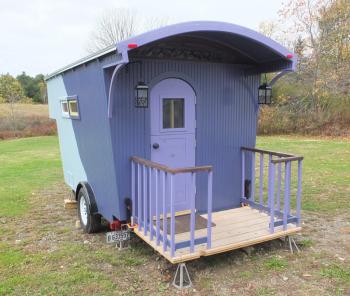SOUTH THOMASTON — John Kazneki owner of the Gypsy Traveler, lives in South Thomaston. A photographer by trade he is making a mark another way, by designing and building the Gypsy Traveler, a small, self-contained camper that fits neatly on a small trailer or truck bed.
"It started out as an idea in the back of my head," he said. "Part of it was to build a camper so I could go to Mount Desert Isle and do my night time photography."
Kazneki originally called it a Gypsy Wagon, but says he got corrected on the name.
"It's more of a Vardo Wagon," he said. "Apparently the name Gypsy doesn't carry a good connotation. I did not realize that, but at the moment it's still a Gypsy Wagon. I didn't know any better and if I offend someone, I'm sorry."
After the first camper was built he said he wasn't in love with it, so he sold it.
"I sold it and installed it on a lady's truck in Connecticut," he said. "When I stepped out of it for the last time I realized that I had sold it. Originally, this was going to go into the back of a pickup truck, but along the way I changed my mind. That's the artist in me and this one is completely different than the first one."
The camper was built on a landscape trailer and weighs about 2,500 pounds. It's built light and has measure less than 100 square feet inside. It is 12 feet long with the bunk, but the lower part is only about four by eight feet.
"It's completely off the grid," he said. "You don't need anything from a campground other then sunlight. There is a compost toilet. The solids go to the back and the liquids go to the front. From what I'm told, the liquids are sterile so they go into a one gallon jug that you later dump out. And when the other half gets filled you find a place to put your compost."
There is a 100 watt solar panel on the roof and a deep cycle battery in the front. Every light that's in it works and you also have a USB port so you can charge whatever you need.
There is a capacity for six gallons of fresh, running water, but no means for hot water. Cooking is done on a camp stove and heat comes form a small two–by-two wood burning stove.
Kazneki said it would cost approximately $20,000 to build each wagon.
"It takes around four to five months to build one," he said. "There are no blueprints and everything is designed as you go along in the shop. It costs around $5,000 to $7,000 in materials alone and the rest is time. People have asked me to build them one, but I would rather build the outside shell and let them finish the inside."
Kaznecki said this particular wagon is not for sale, but he would entertain a request to build one for somebody.
He uses his wagon to travel to Acadia National Park frequently to do nighttime photography.
"I do stars and the Milky Way," he said. "I try to capture the stars reflecting off the water. And I'm like any other photographer; I try to sell the pictures."
Currently the wagon is back in the shop for upgrades and paint on the outside. He said the two-tone paint scheme goes from light blue to dark blue.
"It represents the difference between day and night," he said. "There will the sun and flowers on the light blue part and a moon and stars on the dark."
facebook.com/MysticalViews/?fref=ts
facebook.com/131415787027687/photos/?tab=album&album_id=590781811091080






























